
But what you take and what you leave behind is what makes all the difference. On a multi-pitch climbing day you'll often leave your sack at the bottom whereas when you're scrambling you're usually best just lugging it around with you. Take too heavy a rucksack and you'll soon make Cniefion Arete feel more like the Walker Spur! Over the years I've pared down my kit and it's made a big difference to how much I can do and how much I enjoy doing it. Here are some equipment ideas for your next 'scramble simply' adventure.
Boots
As with most mountain adventures boots make a big difference. Fortunately, when you're scrambling you can just take one type of footwear and it can be whatever you normally head for the hills in. A friend of mine spends all his time in the mountains wandering about in Inov8 trail shoes and it works for him. I'm more in the lightweight boots with supportive ankle support and reasonable waterproofness camp. Any walking boots with a grippy sole, reasonable sole stiffness and edging capability, decent ankle support and comfortable fit will do the job. For a more specialist boot consider something like the La Sportiva Trango S Evo, which I've been using over the last few months.
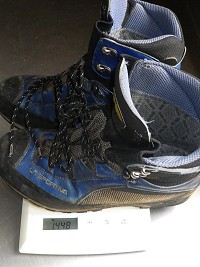
The La Sportiva Trango S Evo has an upper made from Cordura with Lorica reinforcements. Lorica is a fully synthetic material that looks and feels very much like leather. Apparently Lorica means 'body armour' in Latin and it's certainly proving to be very durable. After extensive use these boots still look in perfect condition. To help with waterproofing they also have a Gore-tex insert.
The Evos are light – my pair of size 8s weighs under 1500 grams. The sole unit is quite stiff due to the 7mm nylon insole. When this is combined with the Vibram sole unit the boot is exceptionally good for edging. The toe profile is also quite narrow and they wedge in cracks beautifully.
The sole has a good tread pattern and, although I've heard people say they've found these boots slippy on some surfaces, I have found them to be as grippy as anything else I've used. The sole is quite thin which gives it a precise feel when climbing but another comment I've heard is that they wear out quickly. I haven't found this so far and after a lot of excursions the sole is showing only minimal signs of wear. I suspect that if you regularly walk longer distances the stiff insole and thin sole unit combination will cause it to wear but I don't see this as a general purpose walking boot anyway. The boot can be resoled too.
La Sportiva are known to have a fairly narrow last but, if the Trango S Evo fits you well, I am sure you'll think they are worth every penny of the £180-£200 investment. For their targeted activities of scrambling, via ferrata and general alpinism they are awesome. They will also take a crampon which may be useful for winter excursions. I think you'll be hard pressed to find a better specialised scrambling boot.
More info on the La Sportiva website.
Rucksack
Rucksacks suitable for scrambling should be light, compact, have a secure fit, allow non-restrictive head movement (including allowing you to tip your head back when wearing a helmet) and have a simple uncluttered design. It's also really useful if the sac can be stripped of superfluous straps and gadgets when needed.
I like to fit all my scrambling kit and clothing into something around 30-35 litres and I've used models like the deuter Guide, Black Diamond Speed and Gregory Juxt which all do a great job. I've also been a big fan of Podsacs for many years and some of their new lightweight Lux range are really interesting. The Lux 35 combines all the key attributes of a good scrambling rucksack while being very light and well constructed.
Podsacs Lux 35 RRP £80

The Lux 35 is in the middle of the range's size band with the Lux 45 at the top end down to the Lux 25 and 18 models. I reckon the 35 is the perfect size for scrambling. With all its attachments it weighs in at a respectable weight of 935 grams. You can fit everything in for the walk in then, once helmets, ropes and technical kit are removed, the side compression straps allow you to crank it all up to a compact size.
The Lux 35 is constructed from a very lightweight 100D Cordura body with a heavier duty 630D Nylon Oxford material on the base. Obviously wear is always a trade off between weight and durability and I was interested to see how these materials coped when pitted against coarse rock. I've used the sack in various places including bashing it about for a week on coarse Skye gabbro - so far it's showing no obvious signs of damage at all.
The sack has some good features: A removable supportive plastic frame sheet, well padded back panel, hydration bladder pocket, lid pocket, waist belt with mesh storage pockets, ice axe carrying system and side compression straps. I like the fact that many unwanted features can be removed. For example, the ice axe system can be removed or the back panel can easily be slid out. If all the removable features are stripped off Pod reckon the weight will be reduced to 700 grams. A very lightweight rucksack.
Pod are marketing these sacs as multipurpose. For me the key features for scrambling are light weight, supportive back, stable fit, suitable strippable features and durability. I also want to wear the sack and be able to tip my head to look upwards (including when wearing a helmet). This rucksack ticks all these boxes and is a good scrambling option.
More info on the Podsacs website.
Clothing
Your normal hill clothing will work just fine for scrambling and everyone has their own preferences and budgets. As kit gets lighter there is always a trade off between weight, durability and cost.
Waterproofs are just as vital for scrambling as they are for any day in the British mountains. In fact, scrambling is a popular poor weather activity as you can scramble in any conditions if you're confident enough. However, rough rock will be tough on superlight fabrics like Paclite. How you climb is also crucial. If your climbing technique keeps you well positioned you'll scrape over the rock less than if you tend to thrutch your way up routes. I use lightweight materials as they are light to carry, comfortable to wear and easy to move in - but I get through several pairs of waterproof trousers and at least a couple of tops each year. The choice is yours.
For lightweight jackets I seem to be in a small minority as I love smock style pullovers despite many manufacturers not making them. They tend to be very light, are usually simple and uncluttered in design and they work brilliantly when tucked into a harness. I was delighted when Rab released their Demand Pull On Smock (review by Viv Scott here) and the one I've had has been performing really well. Similar weight models I've used in a jacket style include the Patagonia Stretch Element (review by Jon Griffith here) and Mountain Equipment Particle.

I also rate lightweight fabrics for waterproof trousers despite their drawbacks. Wearing a pair of suitable mountain trousers that will cope well with some moisture means you don't always need over trousers so I don't want to be lugging heavy pants around in my sack. Having said that, if it's a full on monsoon day where I think I'll be in them all the time I'll choose something that's heavier weight. For lightweight models I really like Berghaus Paclite Pants.
A good pair of mountain trousers are well worth the outlay. All the main brands make well cut, comfortable models nowadays. I love my Patagonia Alpine Guide Pants (review by Charlie Boscoe here) which have a great fit and, considering they are made from a reasonably light fabric, seem to wear really well too.
Everyone has their own preference for base layers. I've long been a fan of Patagonia Capilene (news item here) and I tend to use Capilene 1 for scrambling at most times of the year as, if you are operating efficiently, there shouldn't be too much waiting around. For scrambling in the colder months I use Capilene 2.
Fleece insulation is always a talking point. Most of the time I like a lightweight fleece such as Patagonia's R1 hoody. If I'm expecting cold weather I also take either another lightweight fleece layer or a lightweight vest such as Patagonia's R1 vest. On some days I carry a lightweight insulating layer like Patagonia's Nano Puff Pullover (review by Jon Griffith here). Loads has been written about these so I won't go over old ground – except to say this is an awesome item that is, in my opinion, well worth the cost.
I often wear gloves when I'm scrambling. This is frequently because it's cold but can also be to protect my hands from the rock and when using the rope for things like direct belays or short roping. I love Petzl Cordex gloves for general use. They are well fitting and thin enough to be dextrous. I've also been using Beal's Assure Max recently and these are great too. Both of these are durable leather gloves but both get quite water logged in wet conditions (although proofing them with a good wax helps). In wet conditions a more water resistant glove like Mountain Equipment's Randonee is good as it will provide a decent amount of insulation even once water's got in. For the walk ins on cold days I like a simple pair of Powerstretch gloves.
Technical Equipment
I wrote an article on technical equipment for scrambling some years ago and someone commented that they never use any hardware at all on scrambling routes. This is similar to some climbers preferring to solo everything and is a completely valid approach. However, many higher grade scrambles cover quite technical terrain in very exposed positions and having the equipment and skills to protect yourself makes sense to me. The nature of scrambling also means that you may be quite likely, at times, to take a wrong turn and end up needing to retreat. A rope protected descent or short abseil back on to the right line might be the perfect option.
Rope
A 35-40 metre length of thin single rope is a good compromise between usability and low weight. At thinner diameters they will wear out quicker than a thicker rope – particularly if you are doing a lot of direct belays on rock spikes and such like. Thin, slick ropes are also trickier to handle in some situations. It's always worth paying a bit extra for a dry treated one. Beal market a rope that fits the bill called the Scrambler or you could buy a length that's been cut to size off the reel.
The Beal Scrambler is a 35 metre length of Beal's classic Joker climbing rope. At 9.1mm it is thin enough to be light (53 grams per metre) but thick enough to be easy handling and I have had no problems managing this rope when using direct belays, Italian hitches or short roping. The Scrambler is certified as a single rope (as well as a half and twin) so it can be used for everything and could also be used as a cragging rope at shorter venues. It is also, essentially, dry treated.
As this is a very thin single rope I was worried it wouldn't last too well. It has now been used a lot but shows no significant signs of wear at the moment and I have no reason to doubt it will be a very durable rope. As thinner ropes tend to have thinner sheaths it's reasonable to expect them to be more vulnerable to wear and tear so they will need treating with that little bit extra TLC.
I've used loads of Beal ropes over the years and have always found them to be smooth, soft handling ropes. I thought the Scrambler may be the same and I wasn't disappointed. It handles really well and knots easily, feeds easily and is a real pleasure to use. As it tends to come in light single colours I thought it might get dirty quite quickly. It has - and I think the light colours are its only drawback.
I think this is a great rope. Perfect for scrambling and with legendary Beal quality and attention to detail. I appreciated small things like having the middle marked, the dry treatment and the small pack size. I loved the way it performs and appreciate its durability. This is, in my opinion, the perfect scramblers rope.
More info on the Beal website.
Harness
A scrambling harness should be simple, lightweight, easy to put on and take off, with an abseil loop and enough gear loops for a small rack. My top choices are Black Diamond's Bod or DMM's Super Couloir. They both have all the key features needed and because they are fitted 'nappy style' you can put them on or take them off without having to pull the leg loops over your boots. Recently I've been using the R320a Harness from Arcteryx's harness range. This model is proving to be excellent.
Arcteryx R320a Harness RRP £120
I've used a number of Arcteryx items over the years. They've always been beautifully made, highly innovative and brilliantly functional. Having said that – all those positives come at a price and Arcteryx kit is usually top end on cost. Their R320a harness is no exception. At a retail price of £120 it's an expensive choice, but it's also unlike anything else currently on the market.
The R320a utilizes what Arcteryx describe as 'Warp Strength Technology'. This is a system that shares the applied load throughout the harness and from edge to edge of each webbing section. The harness therefore has no padding and you wonder how it's going to perform. Well, in a word, brilliantly. The low bulk makes it feel very unrestrictive and you soon forget you are wearing it. It also means it can pack up very small and the harness comes in a small mesh bag that will squeeze perfectly into your scrambling rucksack. The low bulk also equates to low weight. The R320a weighs in at 320 grams which is a very good weight for a fully specced harness.

Arcteryx market the R320a as a climbing harness rather than simply a scrambling model but the features that make it good for one work well for the other. I don't see any reason why it wouldn't perform really well in winter too. The lack of padding on the waist and legs should ensure it doesn't absorb much liquid and the features you need in winter are all there.
It has adjustable leg loops that make it easy to slide on over boots. It also has 4 full size rigid gear loops that work really well. They allow plenty of gear to be racked but also slope towards the front. This ensures that, as items are removed, the remaining gear will keep sliding forward to an easily accessed position. In addition there is a small loop at the back for racking a belay plate or accessories.
The back of the harness has elastic adjusters to prevent the leg loops from slipping forward on high step up moves. To reduce weight and bulk these are manufactured from very thin elastic. I wonder how they will stand up to being sat on regularly at belay stances or scraped on the rock during wild chimney moves on the Chasm Face? So far they are holding up fine and only time will tell.
The Arcteryx R320a is a brilliant harness. For many years I've favoured a 'nappy style' harness for scrambling but this performs really well as a scrambling model too. It's pricey but I think it might just be worth that extra cash.
More info on the Arcteryx website.
Helmet
By their nature scrambles often follow gully lines or the easier angled aspects of mountains where loose rock can collect. Of course there's also the chance you'll fall or end up banging your head somewhere. For these reasons I always wear a helmet on harder grade scrambles. I prefer one of the lighter weight models as I will usually end up carrying it quite a long way and they are also very comfortable. Petzl's Meteor III+ is great – comfortable, durable and effective but fairly expensive. I've also been using a CAMP Speed model recently. A good alternative if you prefer models with a hardshell is the Petzl Elios which is great value and very comfortable.
CAMP Speed Helmet RRP £90
The CAMP Speed is, according to CAMP, the lightest climbing helmet currently available at 210 grams. It is constructed in the lightweight style of shock absorbing foam covered in a lightweight shell. I have to admit I did a bit of a double take when I opened the box this helmet came in. It is, as the photo below shows, a bright lime green colour. My friends' views on the colour have been polarised – some love it and others have had fun thinking up suitable names to describe it. I've grown to quite like it.
Apart from the colour, the Speed is quite a radical looking lid. There is a pattern on the back where sections of the foam core have been left exposed and the shape is a cross between a climbing, cycling, watersports or skating model. This is partly because it fits into that new breed of cross over helmets that work for things like adventure racing as well as climbing (CAMP also suggest it as suitable for ice climbing as a detachable visor is available), so it's a versatile bit of kit.
I have found the speed to be extremely comfortable although a few friends that tried it thought it sat rather high on their heads. The lightness makes it a pleasure to wear and the cradle and strap system makes for a really supportive, snug fit. There is sufficient venting to keep the air flowing and your head cool. You aren't going to blend into the background in the Speed – but I think it's a great helmet.
More info on the CAMP website.
Hardware
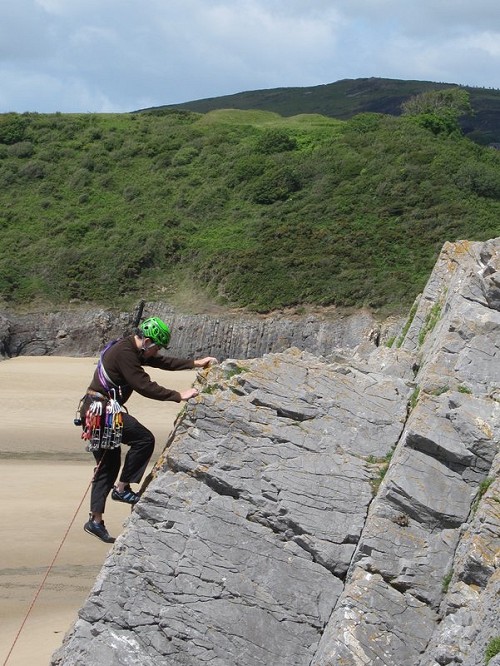
4 x 120cm slings - A staple of your scrambling rack. 10mm dyneema ones are light, versatile and durable. The skinny tape sits well over spikes, can be threaded easily through little gaps and allows knots to be tied in it easily. Sling each with a lightweight screwgate crab such as DMM sentinel and rack them by clipping them doubled on your crab, hold the crab and twist the sling several times then clip the bottom loops back into the crab. This makes it quick to deploy and easier than lobbing them round your shoulder if you're carrying coils.
5, 6, 7 and 8 hexes on dyneema tape with light wire gates on each one. These are light and versatile and can be neatly racked by pulling back the sling through the hex shape slightly and clipping the crab into this loop and the bottom of the sling too. No more thigh slapping! An alternative is a set of DMM Torque nuts (I often just take sizes 1,2 and 3). These are brilliant.
2, 3, 4, 5, 6, 7 and 8 Wild Country Rocks or DMM Wallnuts. Alternatively, consider some Superlight Rocks for the sizes up to 6 (because they only make up to 6!) if you really want to lighten your load. Some people take less but we like the versatility of this size range and it's not too much to carry.
3 x 60cm slings coupled with light biners – rack them tripled so they can be used as superlight quickdraws.
A very light nutkey and crab – Black Diamond's nut key is very strong and light and even has a built in bottle opener for that end of day Stella! If you're into thinking a bit more outside the box consider a bent wire coat hanger. These work well and are very light but obviously not as strong.
Finally, a couple of large HMS crabs suitable for Italian hitches (but they will be indispensable for lots of other jobs too). It's tempting to carry very small ones but the Italian hitch knot needs to be able to swivel around within the curve of the crab so it's one area where light isn't necessarily right. The beefy DMM Boa does this job brilliantly.
Finally, it's worth taking along some bits and bobs for just in case. Some 'tat' that you don't mind leaving behind if needed, a small knife with a serrated blade and a couple of short prussik loops for that 'avoiding the touch' moment (but ensure you know what to do with them).
Other Equipment
The rest is up to you but I'll tell you what I pack and you can decide if this works for you too. A headtorch and spare batteries always live in my rucksack. An alternative I've been using recently is Petzl's Tikka XP2 with a core battery. This is brilliant as I just need to ensure the battery is fully charged and it's good to go.
A map and compass, a small knife, first aid kit, bothy bag, food and drink. I like to pack a really small GPS to allow me to get a grid reference if needed. I very rarely use it but it lives in my sack as a just in case item.
And last but not least don't forget your scrambling guidebook (or the photocopied and laminated pages) – there's no point in having a superlight pack if you can't find the scrambles!

I wondered, as I picked up the lightweight parcel they came in, how this was all going to work. Infact they work great – providing you accept their limitations. 3 sections of carbon fibre joined by a lightweight internal cable is never going to be as durable as a beefier aluminium pole and you can't expect it to be. Carry these with a heavy sack, clatter them through boulder fields or start trying to cross deep snow in them (Black Diamond only categorise them as 3 season) and they won't last long at all. Use them as an ultra light aid to walk into scrambles and you won't find much better.
The poles have a cable that runs up the inside and to set them up you simply slide the poles together and a small pin pops out to lock them into place. That's it! To fold them up you just pop in the pin and pull them apart like the avalanche probe designs that inspired them. They fold up really small and can easily be slid down the back panel of your rucksack. You won't notice you are carrying them until you want that bit of support on the descent.
At about £115 you will have to be sure these are suitable for what you want them to do. But, if you are sure then you'll love them. Suddenly the decision about whether to pack poles is a no brainer and you have all the benefits without the weight penalty. They even come in a neat little mesh bag!
More info on the Black Diamond website.



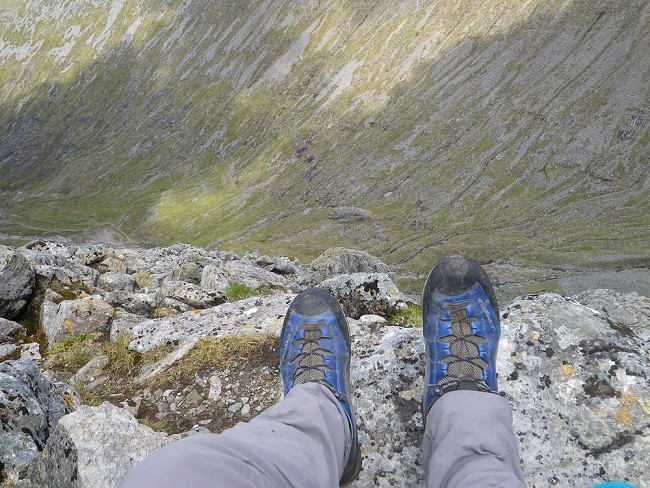
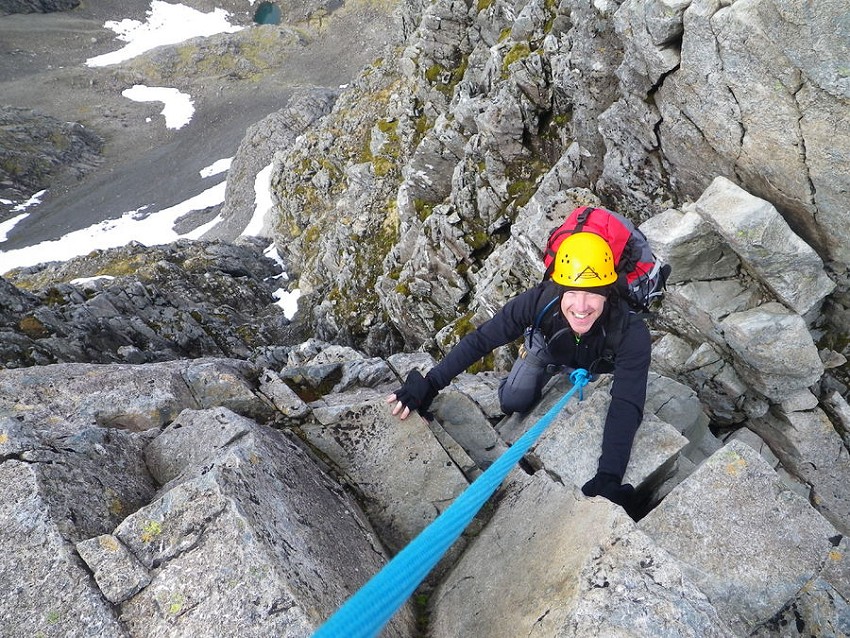

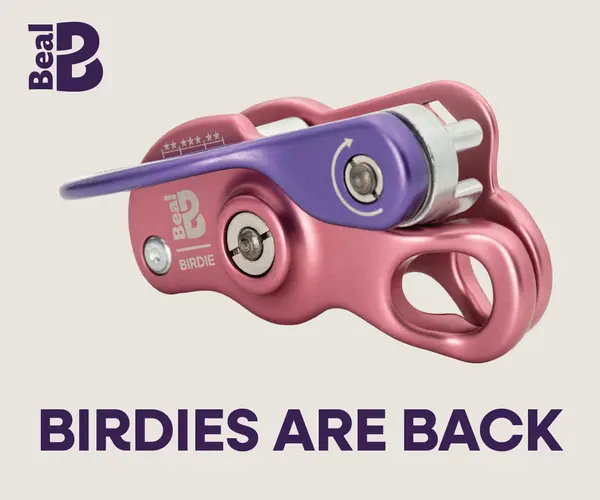







Comments